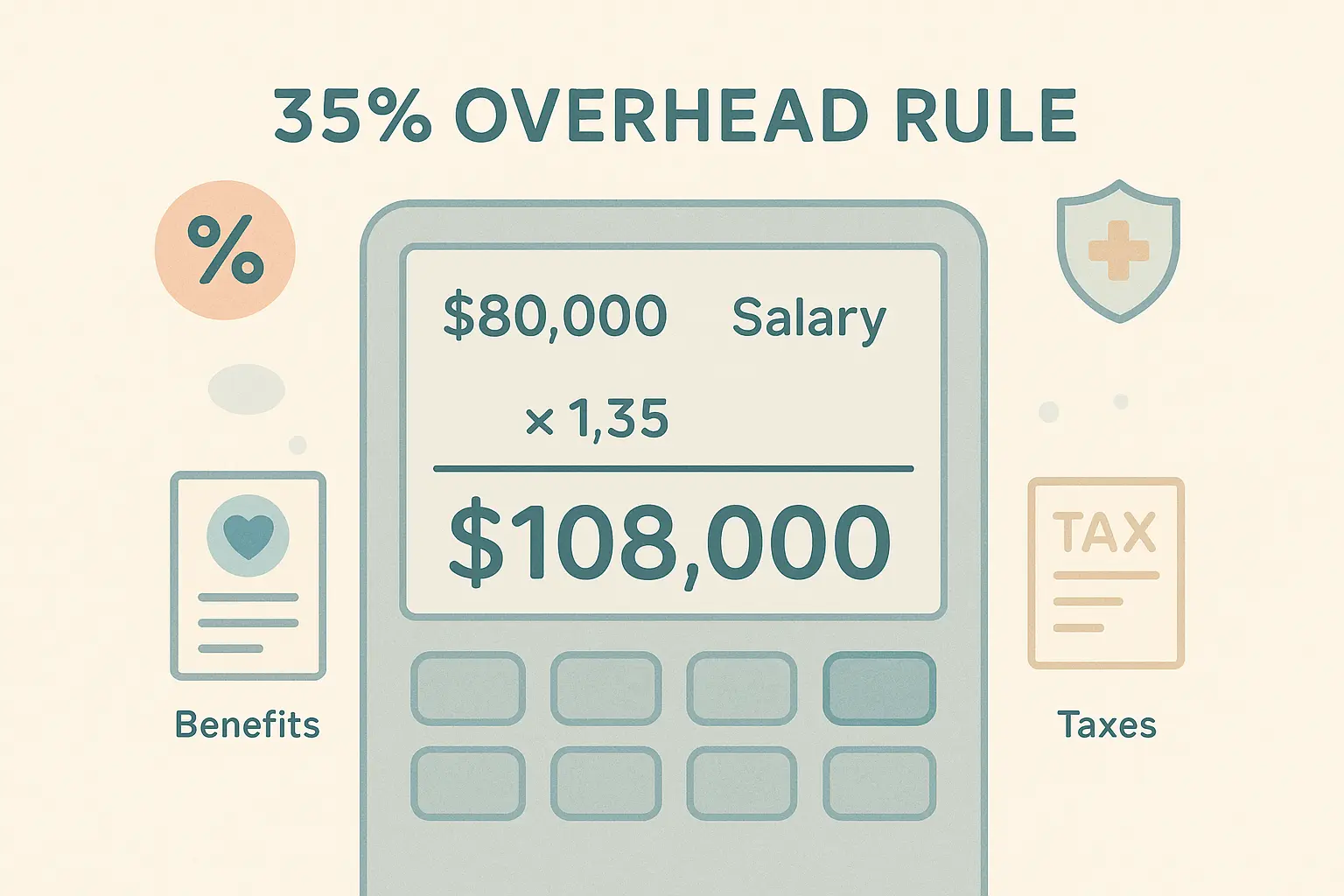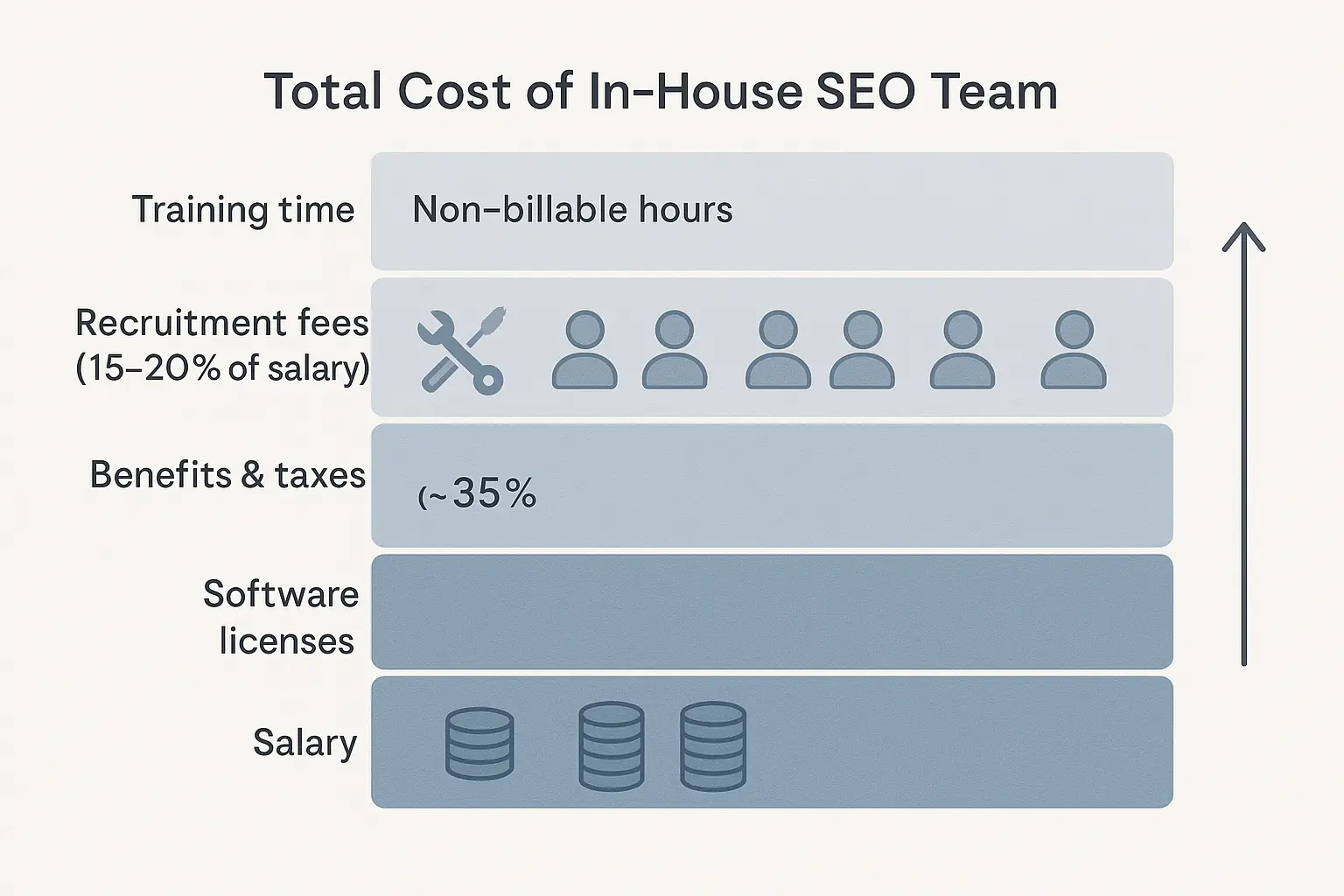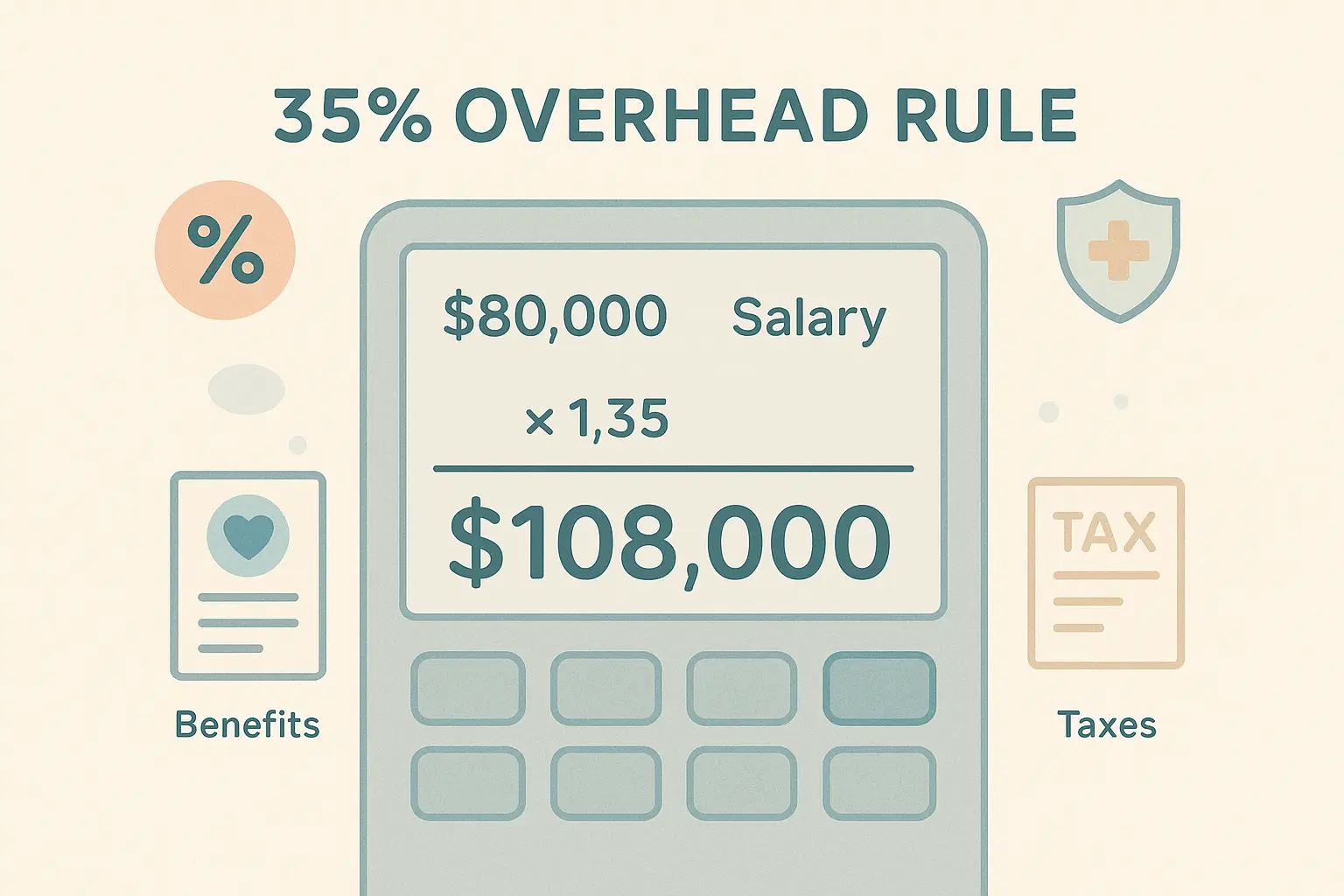You just landed a new client who needs a comprehensive SEO strategy. It’s the perfect opportunity to finally build that in-house SEO team you’ve been dreaming of. You browse a few salary guides, run the numbers, and figure a $75,000 salary for a mid-level specialist fits the budget. The math seems simple enough.
But a few quarters later, you’re looking at your profit and loss statement with a familiar sense of confusion. Revenue is up, but your profit margins have shrunk. Where is the money going?
The truth is, an employee’s salary is just the tip of the iceberg. Beneath the surface lies a massive body of hidden operational costs—recruitment fees, benefits, software licenses, training—that can easily sink an agency’s profitability. Understanding these hidden costs isn’t just smart accounting; it’s the key to building a scalable, profitable agency.
The Tip of the Iceberg: What You Think an SEO Specialist Costs
When you budget for a new hire, the first and most obvious number is their annual salary. With the average salary for an SEO Specialist in the U.S. hovering around $74,778, this is the figure most agency owners plug into their spreadsheets.
This number represents the direct, visible cost of labor. It’s predictable, easy to calculate, and forms the foundation of your financial planning. But stopping here is like seeing only the peak of the iceberg while ignoring the massive, dangerous structure lurking just below the waterline.
Beneath the Surface: The Hidden Costs That Sink Your Profit Margins
The “fully loaded cost” of an employee—their salary plus all the indirect expenses—is where the real financial story emerges. These costs don’t appear as a single line item, which makes them difficult to track, but their cumulative impact on your bottom line is immense.
Let’s dive into the operational overheads that often go unbudgeted.
1. Recruitment & Onboarding: The Price of Finding Talent
Before your new specialist can even start, you have to find them. This process is a significant, front-loaded investment of both time and money.
- Recruitment Fees: Using a recruiter can cost anywhere from 15-25% of the employee’s first-year salary. For a $75k role, that’s an immediate expense of $11,250 to $18,750.
- Job Postings: Listing on platforms like LinkedIn and industry-specific boards adds up quickly.
- Time Is Money: The hiring process itself consumes a huge amount of internal resources. Research shows it can take an average of 42 days to fill a role in the tech sector. Every hour your senior staff spends screening resumes, conducting interviews, and deliberating represents non-billable time diverted from client work or business development.
- Turnover Risk: Perhaps the biggest risk is making the wrong hire. Studies suggest that the cost to replace an employee can range from a staggering 30% to 150% of their annual salary, forcing you to restart this expensive cycle all over again.
2. Benefits, Taxes & Office Overhead
A salary is just one part of an employee’s total compensation package. In the United States, benefits add an average of another 30% on top of an employee’s base pay.
This includes:
- Health, Dental, and Vision Insurance: A significant and often mandatory expense.
- Payroll Taxes: Social Security, Medicare, and unemployment taxes are your responsibility as an employer.
- Retirement Contributions: Matching programs like a 401(k) are crucial for attracting top talent.
- Paid Time Off (PTO): Vacation days, sick leave, and holidays are paid time when the employee is not directly generating revenue.
- Equipment & Stipends: Whether in-office or remote, you’re on the hook for laptops, monitors, software, and potentially home office or internet stipends.
For our $75,000 specialist, that 30% adds another $22,500 per year, bringing the running total to nearly $100,000 before they’ve optimized a single title tag.
3. The SEO “Tech Stack”: A Cost That Scales Per Seat
Modern SEO is impossible without a robust toolkit. Ahrefs, Semrush, Screaming Frog, Moz Pro, and various rank trackers are essential for delivering results. The problem? Most of these platforms are priced on a per-seat or per-user basis.
Hiring a new team member means adding another seat to multiple subscriptions. A single license for a premium SEO tool can run several hundred dollars per month, so a full stack can easily add $500-$1,000 or more in recurring monthly software costs for each new hire. This overhead scales directly with your headcount, quietly chipping away at the profitability of each client account.
4. Non-Billable Hours: The Silent Margin Killer
Not every hour on the clock is a billable one. A significant portion of your team’s time is spent on essential but non-revenue-generating activities:
- Internal Meetings: Team huddles, one-on-ones, and strategy sessions.
- Administrative Tasks: Time tracking, reporting, and responding to internal emails.
- Training & Professional Development: SEO is a field of constant change. Your team needs to spend time learning about new algorithm updates, tools, and tactics. A single hour of employee training costs a business an average of $53.53 in wages, not including the cost of the training itself.
If 15-20% of your specialist’s time is non-billable (a conservative estimate), you’re paying for six to eight hours of work per week that isn’t directly tied to client revenue.
5. The “Ramp-Up” Period: Paying for Potential, Not Performance
No new hire is 100% effective on day one. It takes time to learn your agency’s processes, understand your clients’ unique needs, and get comfortable with your project management style.
This “ramp-up” period, which can last anywhere from one to three months, is a direct operational cost. During this time, you are paying a full salary and benefits package while the employee is operating at a fraction of their full capacity. This delay in ROI is a crucial calculation that many agencies overlook when budgeting for a new role.

From Unpredictable Overhead to Predictable COGS: A Smarter Model
When you build an in-house team, all the hidden costs above fall under Operational Expenses (OpEx). They are variable and unpredictable, making it incredibly difficult to forecast profitability. One bad hire or a sudden need for an expensive new software license can throw your entire financial model off course.
But what if you could change the equation?
Imagine converting all those messy, variable overheads into a single, predictable line item. This is the strategic shift from OpEx to Cost of Goods Sold (COGS). In the agency world, COGS represents the direct costs associated with delivering your service.
By partnering with a white-label provider, you transform the chaotic costs of an in-house team into a fixed, per-client fulfillment cost. You know exactly what it costs to deliver your SEO service each month, allowing you to price your services for guaranteed profitability. This model gives you the agility to scale up or down without the financial risk and administrative burden of hiring and managing employees.

Is Building an In-House Team Always the Wrong Move?
Not necessarily. For a massive, enterprise-level agency with dozens of long-term clients and a need for highly specialized, dedicated staff, an in-house team can be a powerful asset. The resources required to properly recruit, train, and manage that team are substantial, but at a certain scale, it can make strategic sense.
For the vast majority of growing agencies, however, the equation changes. The goal is agile growth, and tying up capital in fixed overheads like salaries and benefits creates financial fragility. The risk of client churn leaving you with an underutilized, expensive team is a constant threat. A more flexible model allows you to match your costs directly to your revenue, protecting your margins and enabling you to invest in growth, not just payroll.

Frequently Asked Questions (FAQ)
What is the “fully loaded cost” of an employee?
The fully loaded cost is an employee’s base salary plus all additional indirect costs, including payroll taxes, insurance, benefits, recruitment expenses, and technology overhead. A common rule of thumb is to estimate this cost at 1.3 to 1.5 times the employee’s salary.
How much time should an SEO specialist spend on training?
Because the SEO landscape changes so rapidly, continuous learning is non-negotiable. A dedicated specialist should expect to spend 5-10% of their time (two to four hours per week) on professional development—reading industry blogs, taking courses, and experimenting with new tools. This is essential for delivering cutting-edge results but is a direct non-billable cost.
Can’t I just hire a junior SEO to save money?
Hiring a junior specialist may seem like a cost-effective solution, but it introduces a new hidden cost: senior staff time. A junior employee requires significant mentorship, supervision, and training from a more experienced (and more expensive) team member. Without that guidance, you risk poor quality work that can damage client relationships.
What’s the difference between OpEx and COGS for an agency?
OpEx (Operational Expenses) are the costs required to run your business, regardless of how many clients you have. This includes things like rent, utilities, and administrative salaries. COGS (Cost of Goods Sold) are the direct costs incurred to deliver your service. For an agency, this would be the cost of the labor or tools used specifically for a client project. Shifting SEO fulfillment from OpEx (a fixed in-house salary) to COGS (a variable per-client partner cost) helps build a more financially resilient and scalable business.
Your Next Step: Calculate Your True Costs
Before you post that job opening, take a moment. Look beyond the salary and map out the true, fully loaded cost of bringing an SEO specialist in-house. When you account for recruitment, benefits, software, and non-billable time, the picture looks very different.
Understanding these numbers is the first step toward building a more profitable and scalable agency. It allows you to make strategic decisions based on a complete financial picture, not just the tip of the iceberg.

